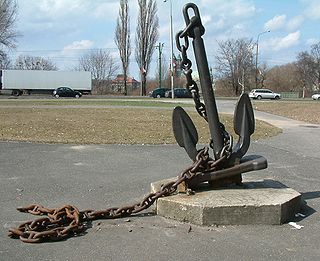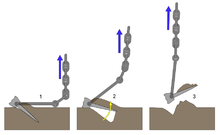
An anchor is a device, normally made of metal, used to secure a vessel to the bed of a body of water to prevent the craft from drifting due to wind or current. The word derives from Latin ancora, which itself comes from the Greek ἄγκυρα.

Seamanship is the art, competence, and knowledge of operating a ship, boat or other craft on water. The Oxford Dictionary states that seamanship is "The skill, techniques, or practice of handling a ship or boat at sea."

A lightvessel, or lightship, is a ship that acts as a lighthouse. They are used in waters that are too deep or otherwise unsuitable for lighthouse construction. Although some records exist of fire beacons being placed on ships in Roman times, the first modern lightvessel was located off the Nore sandbank at the mouth of the River Thames in London, England, and placed there by its inventor Robert Hamblin in 1734. Lightships have become largely obsolete; some being replaced by lighthouses as construction techniques advanced, others by large automated navigation buoys.

An oil platform is a large structure with facilities to extract and process petroleum and natural gas that lie in rock formations beneath the seabed. Many oil platforms will also have facilities to accommodate the workers, although it is also common to have a separate accommodation platform linked by bridge to the production platform. Most commonly, oil platforms engage in activities on the continental shelf, though they can also be used in lakes, inshore waters, and inland seas. Depending on the circumstances, the platform may be fixed to the ocean floor, consist of an artificial island, or float. In some arrangements the main facility may have storage facilities for the processed oil. Remote subsea wells may also be connected to a platform by flow lines and by umbilical connections. These sub-sea facilities may include one or more subsea wells or manifold centres for multiple wells.

The TTSeawise Giant—earlier Oppama; later Happy Giant, Jahre Viking, Knock Nevis, and Mont—was a ULCC supertanker and the longest self-propelled ship in history, built in 1974–1979 by Sumitomo Heavy Industries in Yokosuka, Kanagawa, Japan. She possessed the greatest deadweight tonnage ever recorded. Fully laden, her displacement was 657,019 tonnes.

A mooring is any permanent structure to which a seaborne vessel may be secured. Examples include quays, wharfs, jetties, piers, anchor buoys, and mooring buoys. A ship is secured to a mooring to forestall free movement of the ship on the water. An anchor mooring fixes a vessel's position relative to a point on the bottom of a waterway without connecting the vessel to shore. As a verb, mooring refers to the act of attaching a vessel to a mooring.

"Anchors Aweigh" is the fight song of the United States Naval Academy and unofficial march song of the United States Navy. It was composed in 1906 by Charles A. Zimmermann with lyrics by Alfred Hart Miles. When he composed "Anchors Aweigh", Zimmermann was a lieutenant and had been bandmaster of the United States Naval Academy Band since 1887. Miles was midshipman first class at the academy, in the class of 1907, and had asked Zimmermann to assist him in composing a song for that class, to be used as a football march. Another academy midshipman, Royal Lovell, later wrote what would be adopted into the song as its third verse. Another member of the Naval Academy Band, Willy Perlitz Jr., assisting in writing the music for the different instruments used in "Anchors Aweigh".

Sovereign of the Seas was a 17th-century warship of the English Navy. She was ordered as a 90-gun first-rate ship of the line, but at launch was armed with 102 bronze guns at the insistence of the king. She was later renamed Sovereign under the republican Commonwealth, and then HMS Royal Sovereign at the Restoration of Charles II.

Deal is a coastal town in Kent, England, which lies where the North Sea and the English Channel meet, 8 miles (13 km) north-east of Dover and 8 miles (13 km) south of Ramsgate. It is a former fishing, mining and garrison town whose history is closely linked to the anchorage in the Downs. Close to Deal is Walmer, a possible location for Julius Caesar's first arrival in Britain.

A sea anchor is a device that is streamed from a boat in heavy weather. Its purpose is to stabilize the vessel and to limit progress through the water. Rather than tethering the boat to the seabed with a conventional anchor, a sea anchor provides hydrodynamic drag, thereby acting as a brake. Normally attached to a vessel's bows, a sea anchor can prevent the vessel from turning broadside to the waves and being overwhelmed by them.
This glossary of nautical terms is an alphabetical listing of terms and expressions connected with ships, shipping, seamanship and navigation on water. Some remain current, while many date from the 17th to 19th centuries. The word nautical derives from the Latin nauticus, from Greek nautikos, from nautēs: "sailor", from naus: "ship".

This battle took place on 6, 7, and 8 November 1772, during the Russo-Turkish War (1768–74) in the Gulf of Patras, Greece, when a Russian fleet under Mikhail Konyaev defeated an Ottoman force of frigates and xebecs, destroying all 9 frigates and 10 out of 16 xebecs while losing no ships.

The naval Battle of the Dardanelles took place on 22 May 1807 as a part of the Napoleonic Wars during the Russo-Turkish War of 1806–1812. It was fought between the Russian and Ottoman navies near the Dardanelles Strait.

USS LST-31 was a United States Navy LST-1-class tank landing ship used exclusively in the Asiatic-Pacific Theater during World War II. Like many of her class, she was not originally named and is properly referred to by her hull designation. Later she was named for Addison County, Vermont. She was the only US Naval vessel to bear the name.

USS Broadwater (APA-139) was a Haskell-class attack transport in service with the United States Navy from 1945 to 1946. She was scrapped in 1974.

USS Amphitrite (ARL-29) was one of 39 Achelous-class landing craft repair ships built for the United States Navy during World War II. Named for Amphitrite, she was the third U.S. Naval vessel to bear the name.
Underway, or under way, is a nautical term describing the state of a vessel which is unconstrained from horizontal translational movement relative to the water and the ground. "Way" arises when there is sufficient water flow past the rudder of a vessel that it can be steered. A vessel is said to be underway if it meets the following criteria:
The history of the anchor dates back millennia. The most ancient anchors were probably rocks and many rock anchors have been discovered originating from at least the Bronze Age. Many modern moorings remain reliant upon a large rock as the primary element of their design. However, using pure mass to resist the forces of a storm only works well as a permanent mooring; trying to move a large enough rock to another bay is nearly impossible.
An acoustic release is an oceanographic device for the deployment and subsequent recovery of instrumentation from the sea floor, in which the recovery is triggered remotely by an acoustic command signal.

Koraaga was a Castle-class steel-hulled trawler built in 1914 by Smith's Dock Company, South Bank, Middlesbrough. She was requisitioned as an auxiliary minesweeper operated by the Royal Australian Navy (RAN) in October 1917 for minesweeping duties during World War I, but she was never commissioned. Koraaga returned to be operated commercially as a fishing trawler until she wrecked when she struck a reef off Bass Point whilst carrying returning to Sydney. She was refloated on the tide after having becoming stranded and drifted till she was finally lost five miles (8.0 km) east of Black Head, Gerringong on 10 September 1931.
















